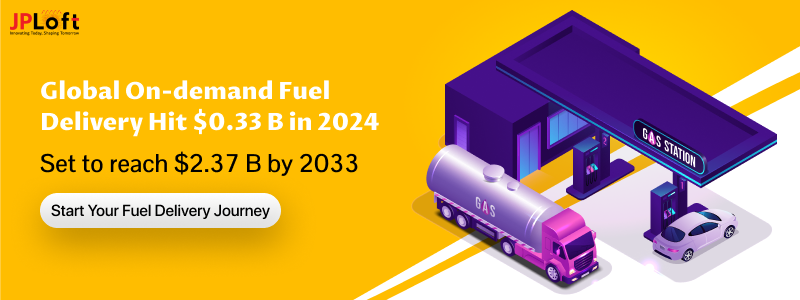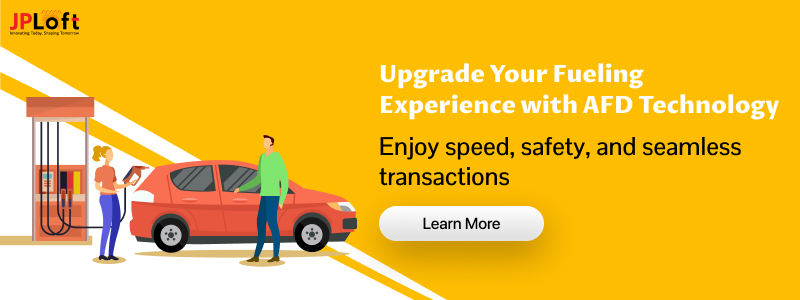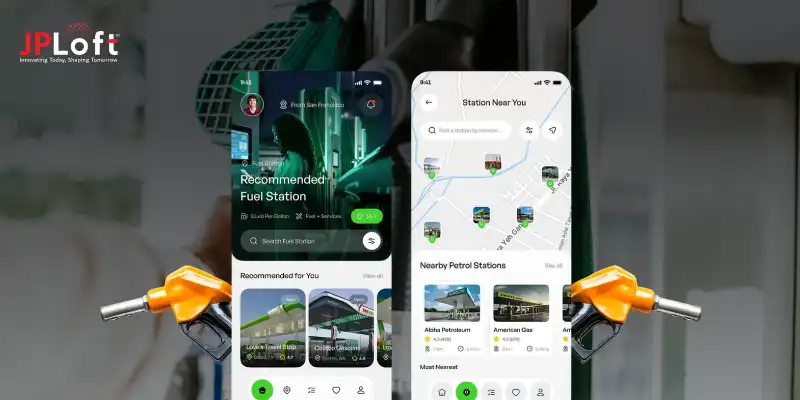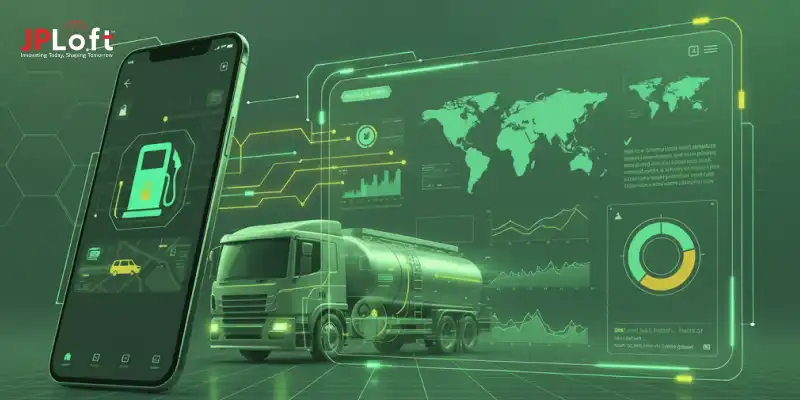What are automated fuel dispensers, and how do they work?
Well, the automated fuel dispensers (AFD) can help you in streamlining the fuel purchase procedure by enabling customers to pay directly at the pump using the card.
When integrated with mobile fuel delivery apps, they extend convenience even further, enabling remote fueling requests, digital receipts, and loyalty rewards.
As John Chambers once said, “At the heart of every successful digital transformation is a seamless, intelligent process that benefits both the business and the customer.”
Following this quote, AFDs are exactly that technology that delivers efficiency, accuracy, and convenience on both sides of the pump.
In this blog, we’ll explore what AFD in fueling is, its components, and how they work in today’s fueling ecosystem.
What is AFD and How It’s Redefining Fueling?
Automated Fuel Dispensers (AFD) can be defined as self-service fueling systems that help customers to refuel vehicles without any direct staff assistance, which further helps to typically use secure, card-based, or digital payment systems.
AFD integrates payment processing, metering, and fuel delivery within a single automated unit that operates 24/4.
Additionally, AFD in fueling helps transform fuel delivery through increasing convenience for the customers, effectively reducing wait times, and enabling round-the-clock service.
However, when it comes to fuel station operators, this AFD can lower labor costs, can enhance transaction speed, and will further result in improving the security with features like EMV compliance and encrypted card readers.
This technique is further helpful to the operators for monitoring fuel levels, observing the sales data, as well as equipment health in real time.
Through blending automation, secure payments, and remote monitoring, AFDs are even assisting fuel stations in delivering faster, user-friendly services and more efficient services, through paving the way for integration with mobile apps and loyalty programs.
When integrated into fuel delivery apps, AFDs can further streamline ordering, payment, and service tracking, creating a unified and highly efficient fueling ecosystem.
One of the important elements that will lay the foundation here will be the key components, while integrating AFD in fueling. Let’s switch to the next section for the same.
Core Components of AFD
The key components of automated fuel dispensers will help you establish the ground.
Along with the fuel delivery app features, when it comes to AFD, you should learn a detail about the core components of AFD.
Hence, look forward to the core components of AFD, below.
1. Fuel Pumping System
One of the core components that you will note here is the fuel pumping system.
It is the mechanical and hydraulic assembly that transfers fuel from underground storage tanks to the vehicle’s tank.
Along with this, the fuel pumping system is equipped with precision controls for managing the flow rate, which helps to minimize spillage and ensure consistent performance even under high-volume operations.
2. Metering Unit
Fuel delivery automatically measures the volume of fuel dispensed, ensuring precise transactions and helping to prevent overcharging. This further helps to comply with the weights and measures regulations.
Furthermore, it often comprises temperature compensation features for maintaining accuracy in different environmental conditions.
3. Payment Interface
Another prime component is a payment interface that incorporates magnetic stripe, chip card leaders, contactless NFC, and mobile wallet payment options for flexibility.
This component is built with encryption protocols for protecting the sensitive payment data and helps to reduce fraud risk. Additionally, it acts as a bridge among the users and the underlying payment networks.
4. Control & Display Panel
When you integrate AFD in fueling, it helps to provide an easy and simple to operate interface with the digital screens for displaying the fuel prices, transaction totals, along with the usage instructions.
This can be further customized to display branding, promotions, or upsell offers during fueling. Under this component, the users should be allowed to manage the drive’s operations and allow for local control via a keypad.
5. Fuel Management System (FMS) Integration
Along with the integration of AFD, one of the significant components to observe is the fuel management system. It is for real-time monitoring of inventory, transactions, and helps to evaluate the dispenser's health.
This helps the operators to optimize stock levels, further effectively to reduce downtime, and plan maintenance schedules proactively.
6. Security & Compliance Systems
This component does help in securing the overall fuel delivery app. It comprises EMV-compliant payment technology, fire suppression readiness, leak detection sensors, and anti-tampering features.
It is an important component that is designed for meeting both the local and international fuel safety as well as payment security standards.
7. Connectivity Module
The connectivity module does provide wired or wireless connectivity for remote diagnostics and for software updates.
This does allow integration with loyalty programs, CRM systems, and even fuel delivery apps for enhancing customer engagement.
However, when it comes to integrating AFD in the fuel delivery apps, you can follow the given table for the components.
|
AFD Component in Mobile Fuel Delivery Apps |
Feature to Include in the App |
|
Remote Pump Activation & Control |
Allow authorized operators to start/stop fuel dispensing directly from the app interface. |
|
Real-Time Fuel Volume Tracking |
Display live data on fuel quantity dispensed, synced with the AFD metering system. |
|
In-App Payment Processing |
Enable secure payments via cards, mobile wallets, or saved payment methods, directly linked to AFD transactions. |
|
Digital Transaction Receipts |
Automatically generate and store receipts within the app, accessible to customers anytime. |
|
Live Price Display |
Show real-time fuel prices from the dispenser inside the app before and during fueling. |
|
Inventory & Stock Monitoring |
Integrate with AFD’s fuel management system to display stock levels for operators and schedule refills. |
|
Security & Compliance Alerts |
Push notifications for leaks, tampering, or EMV payment issues detected by the dispenser. |
|
Loyalty & Rewards Integration |
Automatically apply loyalty points or discounts based on AFD transactions recorded in the app. |
|
Remote Diagnostics & Maintenance Tracking |
Display dispenser health status and allow service requests through the app. |
|
Geofencing for Access Control |
Ensure pump activation only when the authorized delivery vehicle or customer is within range. |
You can connect with the top mobile app development services to integrate these core components of AFD in fueling.
After evaluating the components, let’s evaluate the crucial reasons why AFD matters in 2025 in the following section.
Why Automated Fuel Dispensers (AFD) Matter in 2025?
We understand that with this new concept, you may be confused about whether to integrate AFD into the fuel delivery apps or not. It is also important to implement this key component in the fuel delivery stations.
With the growing market for fuel delivery apps, it has become increasingly important to make fuel accessible to customers by providing them with convenience.
Here is the list of fuel delivery market stats that provide you with reasons to go with updating the AFD.
- The mobile fuel delivery market size is expected to grow from USD 5.84 billion in 2025 to USD 11.93 billion by 2035 at a CAGR of 7.4%.
- The global on-demand fuel delivery market size was USD 0.33 billion in 2024, and the market is further projected to touch USD 2.37 billion by 2033, representing a CAGR of 15.97% during the period from 2025 to 2033.
- Additionally, the fuel delivery system market size stood at USD 5.13 billion in 2025 and is further forecasted to reach USD 6.74 billion by 2030.
You can create a fuel delivery app and contribute to this growing revenue after updating your fuel delivery app and stations with AFD.
Along with the growing numbers in the fuel delivery sector, let’s consider the top reasons to include AFD in fueling from the perspective of the customers as well as according to the businesses.
► Benefits for Customers
- 24/7 access to fueling without relying on staff availability.
- Faster service with reduced wait times at stations.
- Contactless payment options via cards, NFC, or mobile wallets.
- Transparent fuel prices are displayed in real time.
- Option to link with fuel delivery apps for remote payment, tracking, and digital receipts.
► Benefits for Businesses
- Reduced labor costs by minimizing staff dependency at dispensers.
- Higher transaction speed, increasing customer throughput.
- Real-time inventory and sales data for better stock management.
- Predictive maintenance alerts to avoid downtime.
- New revenue streams through app integration, loyalty programs, and targeted promotions.
Now, are you ready to integrate AFD in fueling?
If yes, then let’s learn what it will look like in the traditional stations and in the fuel delivery apps in the following section.
AFD in Traditional Stations vs. Fuel Delivery Apps
When you integrate AFD, it's significant to learn about its implementation for both the traditional stations and the fuel delivery apps.
Let’s learn it all here.
A] AFD in Traditional Stations
Traditional fuel stations' Automated Fuel Dispensers (AFD) prioritize accuracy, speed, and minimizing human error when filling up tanks.
In addition to frequently integrating with POS systems for safe card payments and loyalty programs, they allow customers to refuel without the need for manual intervention.
Both customers and station operators benefit from features like automatic shut-off, pre-set fueling options, and real-time fuel metering. Additionally, AFD lowers the need for staffing and lowers the possibility of overflows or incorrect calculations.
Businesses benefit from improved safety standard compliance, quicker service cycles, higher throughput, and consistent fuel measurement.
The user experience is still location-bound, though, requiring users to physically visit the station. Therefore, users do not have to stay location-bound when using fuel delivery apps.
B] AFD in Fuel Delivery Apps
When integrated as an API into mobile fuel delivery apps, AFD shifts from being just a station-side tool to a mobile-enabled service component.
In this case, the AFD is installed on delivery trucks and connected to GPS, IoT sensors, and app-based controls. The AFD guarantees accurate, automated dispensing at the user's location, and customers can place fuel orders through the app.
Digital receipts, usage tracking, and automated billing are all made possible by the integration. Businesses gain from reduced manual intervention, fuel usage analytics, and optimized delivery routes, which increase productivity and profitability.
Customers find it convenient because they can fuel without leaving their homes or workplaces, giving them a competitive advantage in the expanding on-demand economy.
Let’s summarise it all in the table mentioned below.
|
Aspect |
AFD in Traditional Fuel Stations |
AFD in Fuel Delivery Apps |
|
Accessibility |
Available only at physical station locations. |
Delivers fuel directly to the customer’s location. |
|
Customer Convenience |
Requires the customer to travel and wait at the station. |
Enables fueling without leaving home, work, or the site. |
|
Technology Integration |
Integrated with station POS systems, loyalty cards, and payment terminals. |
Integrated with mobile apps, IoT sensors, GPS, and in-app payments. |
|
Operational Efficiency |
Speeds up fueling at stations, reducing queues. |
Optimizes delivery routes and automates fueling at multiple stops. |
|
Accuracy & Safety |
Ensures accurate fuel measurement and prevents overflows on-site. |
Offers precise fuel dispensing with automated shut-off during mobile delivery. |
|
Business Benefits |
Increased service throughput, lower staffing needs, improved compliance. |
Wider service reach, better analytics, and higher customer retention through convenience. |
|
Limitations |
Location-bound, cannot serve remote users without station access. |
Requires well-maintained delivery vehicles and regulatory compliance for mobile fueling. |
Till now, we have explored the concept of AFD, core components, the difference between its implementation in stations and apps, as well as its overall benefits for customers and for businesses.
After considering the AFDs in both scenarios, let’s learn about the complete role in the following section.
Role of AFD in Fueling
Learning about the role of AFD in fueling helps in identifying the functionalities of AFD in fueling.
Let’s explore it all in this section.
► Enable Self-Service Fueling
AFDs enable customers to perform all aspects of fueling independently, including payment and pump activation, without any need for personnel intervention.
► Minimize Customer Wait Times
By allowing direct payment at the pump, AFDs reduce wait times, particularly during peak periods, enhancing the entire station experience.
► Enable 24/7 Access
Fuel stations with AFDs can provide 24/7 access to fuel, enabling customers to fuel at any time without being restricted by personnel working hours.
► Enable Multiple Payment Options
They accommodate multiple payment options, including credit/debit cards, mobile wallets, NFC payments, and integration with loyalty or reward schemes.
► Ensure Accurate Fuel Measurement
Integrated calibration mechanisms ensure accurate fuel dispensing, avoiding losses to station owners and customers receiving the amount paid for.
► Lower Operational Costs
Lower personnel requirements and streamlined operations enable fuel station owners to save on labor expenses without affecting service quality.
► Enable Real-Time Sales & Inventory Tracking
AFD systems commonly integrate with rear-end management systems, providing station owners with immediate visibility into fuel sales, inventory levels, and performance metrics.
► Improve Customer Convenience
The combination of speed, flexible payments, and self-service all translates into a faster, more enjoyable fueling experience.
Now, let’s explore the implementation strategies related to AFD in fuel delivery apps, within the following section.
Implementation Strategies for Automated Fuel Delivery
When you start an online fuel delivery business, it's crucial to consider the latest technologies to boost its presence in the competitive market.
Hence, let’s evaluate the overall implementation strategies for integrating AFD.
Step 1: Define Scope, Use Cases, and Compliance Needs
Before deploying, clarify the exact role of AFD in your business model. For stations, decide if you’re upgrading existing dispensers or building new self-service lanes.
For apps, outline mobile refueling options, such as on-demand, scheduled, or subscription-based services.
At the same time, identify legal requirements, including fuel handling permits, EMV/PCI compliance for payments, hazardous material transport rules, and data privacy laws. Addressing regulatory needs early prevents costly rework later.
Step 2: Hardware and Connectivity Setup
Your AFD rollout depends on the devices and their connections. Stations need EMV-certified dispensers, vapor recovery systems, and Automatic Tank Gauging (ATG) for real-time inventory.
Apps require truck-mounted, MID-certified meters, GPS tracking units, and auto shut-off nozzles for safety.
Ensure all devices have secure LTE or 5G connectivity with backup Wi-Fi or satellite links. Use a VPN or private APN for safe data transfer.
Step 3: Payment and Transaction Security
AFD must allow smooth and secure transactions. In stations, integrate EMV chip readers, contactless payments, and in-dispenser receipt printing.
In apps, support mobile wallets, 3-D Secure authentication, and tokenized card storage.
All payment processes should meet PCI DSS requirements, encrypt data from end to end, and log transactions for audits.
Step 4: API Integration and Fuel Management System Sync
AFD equipment should easily connect with your Fuel Management System (FMS) or IoT backend.
This allows real-time updates on fuel levels, pricing, dispensing status, and operational health. For stations, APIs can automate price adjustments across pumps.
For apps, APIs enable dispatch scheduling, driver routing, and in-app live fueling status for customers.
Step 5: Safety Controls and Emergency Interlocks
Safety is essential. Equip both stationary and mobile units with emergency stop buttons, leak detection, overfill prevention, and auto shut-off mechanisms.
Connect these safety features to your control system so unauthorized or unsafe dispensing attempts are blocked immediately.
These measures reduce the risk of accidents and build trust with customers.
Step 6: Testing, Pilot Runs, and Staff Training
Before full-scale deployment, conduct dry and wet tests to validate hardware accuracy, software stability, and user flows.
Start with a limited pilot at one station or in a small delivery zone to identify real-world issues. It is important to go for fuel delivery app testing.
Train your teams in AFD operations, safety procedures, troubleshooting, and customer service so they can manage both automated and manual overrides when necessary.
Step 7: Monetization and Ongoing Optimization
Once AFD is live, explore revenue models beyond basic fueling. Stations can offer loyalty points, premium fueling lanes, or bundled car services.
Apps can offer subscriptions for automatic refills, surge pricing for urgent requests, or cross-sell vehicle maintenance. Fuel delivery app maintenance is one of the crucial aspects to consider when it comes to enhancing the app’s performance.
Continuously track KPIs such as transaction time, cost per delivery, NPS (Net Promoter Score), and machine uptime; then refine operations accordingly.
Considering these steps, you can integrate AFD in the fuel stations as well as in the fuel delivery apps.
Now, let’s look for the real-world cases of AFD in fueling within the following section.
Real-World Cases of AFD in Fueling
Learning and implementing AFD can be difficult; however, when you evaluate how the top fuel delivery apps are doing in the current industry, this will help you in identifying how you can lead this industry.
Let’s figure it out in this section.
Case Study 1: Cenex
Cenex is one of the key apps that is incorporating AFD systems in delivering fuel. These systems incorporate tank sensors, automated refilling, and billing by deferred or by usage. Cenex markets AFD as an efficiency and operational reliability improvement method.
Case Study 2: CFS Fuel Services
Integrates AFD to provide a continuous fuel supply, activating deliveries according to actual tank levels and usage patterns. This analytical method optimizes delivery routes, reduces operational expenditures, and avoids last-minute fuel purchases. CFS positions AFD as a convenience as well as a cost-control tool.
Case Study 3: United Quality Cooperative
Utilizes sensor-based AFD to remove manual checks, streamline delivery schedules, and provide deferred or average-monthly billing. Through automatic replenishment, they minimize downtime and enhance fuel management for agriculture and commercial customers. The system also enhances transparency with usage-based reporting.
Case Study 4: River Valley Cooperative
Uses AFD technology to ensure the availability of fuel and decrease downtime, particularly for agriculture and business customers. Their system enables them to anticipate seasonal spikes in demand, enhancing customer confidence and retention. It also allows employees to be able to focus on more profitable service operations instead of constantly checking tank levels.
Well, after considering these case studies related to AFD in fueling, another prime factor that you need to evaluate is monetization opportunities with AFD.
Let’s learn about the same in the following section.
Monetization Opportunities with AFD-Enabled Stations & Apps
It's significant to learn about the key fuel delivery monetization strategies that help businesses to cover costs, make a profit, and help to adapt to the evolving digital landscape.
Let’s learn about the monetization opportunities with AFD-enabled stations & apps, below.
1] Monetization Strategies for AFD-Enabled Fuel Stations
Here is the list of the top monetization strategies for AFD-enabled fuel stations to consider.
A) Subscription Plans
This is a significant option to consider when it comes to earning via adding AFD-enabled fuel stations. Here, you can offer users annual, monthly, or weekly subscription plans to the users.
The customers pay a fixed monthly fee for the automated refills, through ensuring predictable revenue for the station. These plans help to eliminate the hassle of placing individual orders, guaranteeing an uninterrupted fuel supply and locking the customers into long-term relationships.
B) Premium AFD Services
The premium AFD services can be defined as an additional plan that helps users buy these premium versions, providing flexibility and convenience packages with benefits such as priority refilling during peak demand, accelerated delivery, or special discounts on fuel and lubricants.
Additionally, the premium AFD services offer tiered packages with perks such as priority refills during high-demand periods, faster delivery, and exclusive discounts on fuel and lubricants.
Offer tiered packages with perks like priority refills during high-demand periods, faster delivery, or exclusive discounts on fuel and lubricants.
C) Data-Driven Partnerships
The data-driven partnerships can be defined as the collaborations where stations leverage the real-time consumption, delivery, and operational data that is collected through their AFD systems helpful to create new revenue streams as well as strategic alliances.
These automated fuel dispensers are self-anonymized, aggregating data related to fuel consumption to logistics, analytics, and agri-companies helpful to enhance the overall supply chain productivity.
D) Advertising and Co-Branding
Under this monetization parameter, you should team up with the neighbourhood businesses or machinery brands to feature promotions on the delivery trucks, tank sensors, and in the customer's dashboards.
Other than this, co-branding is one of the important perspectives to be included for utilizing the multiple brand names that will help earn a regular income.
Now, let’s look forward to the monetization strategies for the AFD-enabled fuel delivery apps in the following section.
2] Monetization Strategies for AFD-Enabled Fuel Apps
Here is the list of the top monetization strategies for AFD-enabled fuel apps to consider.
A) In-App Advertising
When it comes to the AFD integration in the fuel delivery apps, it is important to look for the advertising parameters. Here, you can connect with multiple brands and provide them with a space to advertise their brand.
Along with this, it can be a regular source of income for your brand, as you can charge a regular source of income from these brands.
B) Pay-Per-Delivery Fees
Pay-per-delivery fees are a charge for a convenience fee for each automated refill.
One of the core benefits of the same is that it works well for customers who don’t want the long-term commitments, although they still value AFD’s convenience.
Another crucial pay-per-delivery fee monetization model advantage is, it helps to provide scalability.
It does offer a fee that can be dynamic, adjusting to distance, urgency, or is effective for a particular time of day. These fees can vary depending on current pricing behavior.
C) Fleet & Corporate Contracts
This can be a lucrative monetization strategy that does provide a reliable stream of revenue through long-term agreements with businesses.
Here, you can partner with the businesses to handle all their fueling needs on a contractual basis.
It is an effective monetization strategy that provides benefits to the large and stable accounts with high fuel turnover.
Along with this, it adds value to the businesses by adding value and providing an integrated fuel usage analytics.
After learning about the monetization strategies, let’s evaluate the core challenges and solutions, as when you enter among the competitors like CAFU, Booster, and others, it's important to identify and overcome challenges soon.
Let’s cover it all in the following section.
Challenges and Solutions in AFD Integration
Identifying the challenges in building a fuel delivery app will be totally different than considering integrating AFD in fueling.
Hence, here is the list of challenges that you need to overcome.
-
Security as a Challenge
You should note that the AFD systems do help to collect sensitive usage, location, and payment data, which makes the app a target for cyberattacks.
Thus, you need to enable security that can help in enhancing trust among the users and help in improving the overall brand’s performance.
-
Technology Compatibility Issues
Technology compatibility issues can impact the overall AFD integration.
These issues can arise when the diversified components of the system, such as hardware, software, networks, etc., do not work effectively together, which might result in errors as well as can lead to reduced functionality.
Developing cross-platform applications can be a solution by including effective technologies.
-
Device Compatibility
Another critical aspect that you might face is the device compatibility challenge focuses on ensuring that the app functions on different devices including smartphones, desktops, and tablets.
Along with this, device compatibility arises when the app or service requires features as well as specifications that the device lacks. This will impact the user experience on a large scale.
-
High Initial Costs vs. ROI
AFD setup requires significant investment in sensors, automation systems, and integration. Starting with pilot projects and exploring leasing or subsidies can reduce financial risk.
IoT-enabled tank sensors, automated dispensers, monitoring software, and integration with the existing POS or ERP systems. AFD integration depends on significant upfront spending on IoT sensors, automated dispensers, and system integration.
You can follow these challenges and solutions, and can overcome them to enhance the overall theme with strategic practice.
Future of AFD in Fueling
Well, one of the future trends in fuel delivery is AFD; however, you should know what AFD can bring to the table in the next 5 years.
Hence, learning about the future of AFD in fueling is important to identify how you can grow in the future and how it can be impactful.
Let’s consider the following list.
-
- Transition to Predictive Service Models – Real-time monitoring and IoT sensors will allow for proactive, automated refills in place of reactive fuel ordering.
- Efficiency for Fuel Stations – Smart tank monitoring will decrease manual verification, eliminate wastage, and streamline delivery routes to cut costs.
- Customer Benefits – Fleets, industries, and farms will have an uninterrupted supply, clear tracking of usage, and customizable subscription plans.
- Expansion for Fuel Delivery Apps – Apps will transform from on-demand refueling to sensor-initiated deliveries, promoting long-term contracts and loyalty.
- Sustainability Impact – Reduced schedules and overfills will eliminate fuel transport emissions, enabling environmental compliance.
- Data-Driven Revenue Streams – Usage analytics will create opportunities for partnerships, targeted promotions, and operational insights.
- Future Industry Standard – As automation, AI, and compliance technology evolve, AFD adoption will be the rule of the game in the next decade.
- Early Adopter Advantage – Companies that adopt AFD earlier will have a competitive advantage in efficiency, market position, and customer retention.
Partner with JPLoft for AFD-Ready Fuel Delivery App Development
JPLoft is a leading fuel delivery app development company offering solutions built for efficiency, innovation, and scalability.
With expertise in integrating Automated Fuel Delivery (AFD) features, JPLoft ensures your app is equipped for real-time tank monitoring, automated refill scheduling, and seamless payment processing.
Our development process focuses on creating user-friendly interfaces for both customers and operators, while incorporating advanced IoT integrations, GPS tracking, and secure data management.
Whether you serve individual customers, fleets, or industrial clients, JPLoft delivers tailored solutions to streamline operations, reduce costs, and enhance customer satisfaction.
By choosing JPLoft, you gain access to a team experienced in fuel industry technologies and regulatory compliance, ensuring your app is market-ready and future-proof.
Partner with us to transform your fueling services into a smart, automated, and highly profitable business with cutting-edge AFD capabilities.
Conclusion
AFD is redefining the fueling industry by merging automation, IoT, and secure payment technologies to create a faster, safer, and more efficient experience.
From reducing operational costs for fuel stations to enabling proactive refueling for delivery apps, its benefits span both business efficiency and customer convenience.
With market growth projections signaling strong demand, early adoption of AFD can position businesses as industry leaders.
By integrating it into fuel stations or mobile apps, operators can unlock new revenue streams, enhance service quality, and stay ahead in a competitive landscape, paving the way for the future of fueling in the digital era.
FAQs
AFD, or Automated Fuel Dispenser, enables self-service fueling with secure payments, automation, and real-time monitoring for improved efficiency.
It offers 24/7 fueling access, faster service, contactless payments, real-time pricing, and integration with fuel delivery apps for convenience.
AFD reduces labor costs, speeds transactions, optimizes inventory, enables predictive maintenance, and creates new revenue through loyalty programs and promotions.
Yes, AFD integrates with apps to enable automated mobile refueling, in-app payments, digital receipts, and accurate dispensing anywhere.
Key components include the fuel pumping system, metering unit, payment interface, control panel, fuel management system, security systems, and connectivity module.
Yes, initial setup is expensive, but ROI comes from efficiency gains, reduced downtime, increased customer retention, and new monetization models.













Share this blog